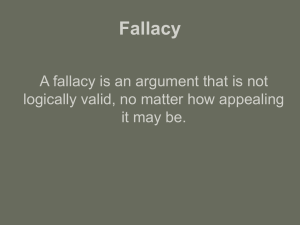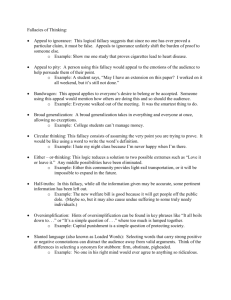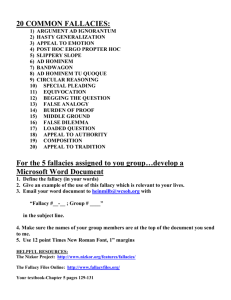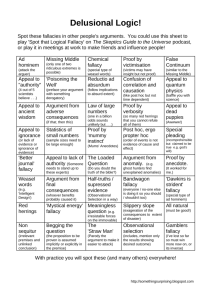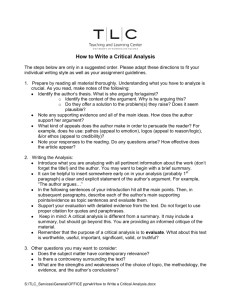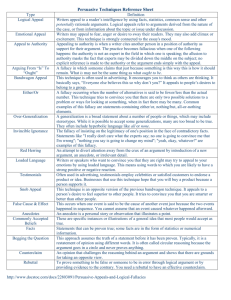Nonsense Robert J. Gula
advertisement
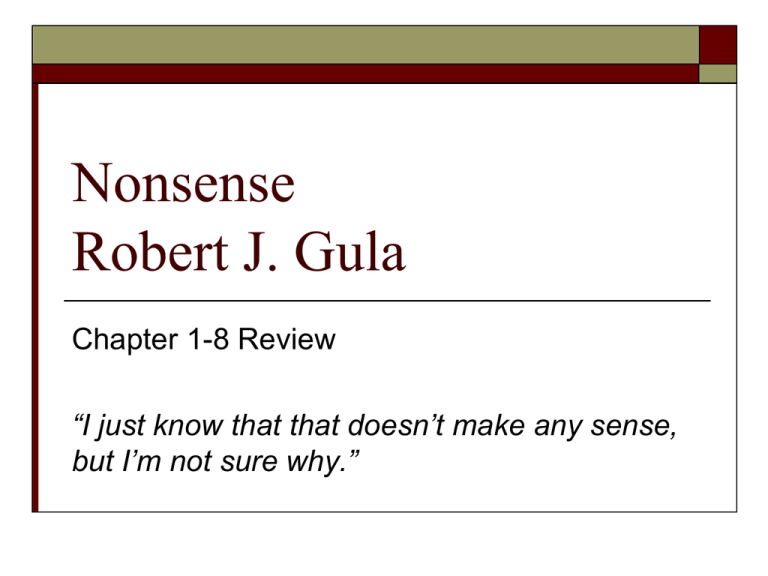
Nonsense Robert J. Gula Chapter 1-8 Review “I just know that that doesn’t make any sense, but I’m not sure why.” Chapter 1 Everyday Nonsense General Principles… “Patterns that seem to characterize the ways that people tend to respond and think…” People: 1. “Tend to believe what they want to believe 2. Tend to project their own biases or experiences upon situations General Principles Cont. 3. tend to generalize from a specific event 4. tend to get personally involved in the analysis of an issue and tend to let their feelings overcome a sense of objectivity 5. are not good listeners (hear selectively) 6. are eager to rationalize 7. are often unable to distinguish what is relevant from what is irrelevant General Principles Cont. 8. are easily diverted from the specific issue at hand 9. are usually unwilling to explore thoroughly the ramifications of a topic; tend to oversimplify 10. often judge from appearances 11. often simply don’t know what they are talking about, especially in general discussion General Principles Cont. 12. rarely act according to a set of consistent standards 13. often do not say what they mean and do not mean what they say” “Most people want to feel that issues are simple rather than complex, want to have their prejudices confirmed, want to feel that they ‘belong’ with the implication that others do not, and need to pinpoint an enemy to blame for their frustrations.” --J.A.C. Brown, Techniques of Persuasion Chapter Two Emotional Language What are certain emotional needs that people have? Why is a person who knows how to deceive us dangerous? Why is it important for people to know how their emotions can be preyed upon? APPEAL TO PITY “Instead of giving carefully documented reasons, evidence, and facts, a person appeals to our sense of pity, compassion, brotherly love.” PLEA FOR SPECIAL TREATMENT A variation of the appeal to pity APPEAL TO GUILT Three points about the appeal to guilt 1. “No one has the right to prey upon our emotional balance 2. Unless sound reasons can be given for the speculation that we ought to feel guilty, that speculation is worthless 3. Even if we were to feel guilty, we have been given no reasons to do what the ad suggests.” APPEAL TO FEAR “Tries to frighten us into a specific action or into accepting a specific belief.” “‘If you don’t do X, then Y will happen.’” Sometimes personally directed Sometimes more subtle APPEAL TO SINCERITY –noun, plural -ties. freedom from deceit, hypocrisy, or duplicity; probity in intention or in communicating; earnestness. www.dictionary.com APPEAL TO SINCERITY “A person adopts a very earnest, sincere, possibly self-effacing, and certainly humble tone.” “The emphatic verb forms (forms with the auxiliaries does and do) and adverbs– really, genuinely, truly, absolutely, actually– are used to add to the feeling of sincerity.” APPEAL TO HOPE noun 1.the feeling that what is wanted can be had or that events will turn out for the best: to give up hope. 2.a particular instance of this feeling: the hope of winning. 3.grounds for this feeling in a particular instance: There is little or no hope of his recovery. 4.a person or thing in which expectations are centered: The medicine was her last hope. 5.something that is hoped for: Her forgiveness is my constant hope. www.dictionary.com Sometimes, hope is all we have… APPEAL TO FLATTERY –noun, plural -ter⋅ies. 1.the act of flattering.2.a flattering compliment or speech; excessive, insincere praise. www.dictionary.com “When we are flattered, we tend to confuse our positive feelings toward the flatterer with what that person is actually saying.” APPEAL TO STATUS –noun 1.the position of an individual in relation to another or others, esp. in regard to social or professional standing.2.state or condition of affairs: Arbitration has failed to change the status of the disagreement. 3.Law. the standing of a person before the law.–adjective 4.conferring or believed to confer elevated status: a status car; a status job www.dictionary.com APPEAL TO THE BANDWAGON Appeals to our need to belong APPEAL TO LOVE/ APPEAL TO TRUST/ APPEAL TO FRIENDSHIP “’Either you’re with me or you’re against me!’ ‘If you really trusted (loved) me, then you’d go along with me!’” BTW– not going along with someone doesn’t mean that you do not love or trust that person, or that you are not his or her friend “…remember that true friendship sometimes demands that we disagree.” APPEAL TO PRIDE OR LOYALTY PRIDE–noun 1.a high or inordinate opinion of one's own dignity, importance, merit, or superiority, whether as cherished in the mind or as displayed in bearing, conduct, etc.2.the state or feeling of being proud.3.a becoming or dignified sense of what is due to oneself or one's position or character; self-respect; self-esteem.4.pleasure or satisfaction taken in something done by or belonging to oneself or believed to reflect credit upon oneself: civic pride. 5.something that causes a person or persons to be proud: His art collection was the pride of the family. 6.the best of a group, class, society, etc.: This bull is the pride of the herd. 7.the most flourishing state or period: in the pride of adulthood. LOYALTY-–noun, plural -ties. 1.the state or quality of being loyal; faithfulness to commitments or obligations.2.faithful adherence to a sovereign, government, leader, cause, etc.3.an example or instance of faithfulness, adherence, or the like: a man with fierce loyalties. www.dictionary.com ARGUMENTUM AD POPULUM … “the appeal to the crowd, to the mob, to the gallery.” Chapter 3 Emotional Language: Propaganda BANDWAGON “’Everyone is doing it. Therefore, you should be doing it too.’” REPETITION “The propagandist says something over and over again.” CONFIDENCE “The propagandist also speaks confidently. He gives the impression of knowing what he is talking about.” EARNESTNESS AND SINCERITY “The more earnest and sincere a person appears, the more readily he will be believed.” OVERSIMPLIFICATION “The propagandist takes one side of the situation and treats that one side as if it were the only side.” NAME-CALLING “The propagandist assigns abusive epithets or uses names that have strong pejorative emotional associations to people or ideas he doesn’t like, and he assigns flattering epithets or uses names that have strong positive emotional associations to people or ideas he does like.” STEREOTYPING “The propagandist takes one characteristics of a person, exaggerates it, and then regards it as the only characteristic.” THE GLITTERING GENERALITY “The propagandist makes broad, sweeping statements, usually ones with complex and far-reaching ramifications, but he ignores the complexities and the ramifications.” SLOGANS “The audience will remember the clever slogan without challenging the meaning…” TRANSFER “This technique encourages us to transfer our emotions from one source to another.” TESTIMONIAL “An important or prominent person or organization speaks on behalf of an idea or product.” PLAIN FOLKS “I’m just like one of you.” SNOB APPEAL “… propaganda may exploit a person’s need for status or his desire to feel special.” STATISTICS WITHOUT CONTEXT “The propagandist may give you plenty of statistics, but he rarely gives you the background of those statistics.” LARGE NUMBERS “…a variation of the bandwagon technique.” THE MANUFACTURED PROBLEM– THE BAD GUY, THE SCAPEGOAT “The propagandist creates or exaggerates a problem, tries to convince you how serious the problem is, and then appeases you by blaming someone for that problem or by suggesting that his proposal will solve the problem.” ARRANT DISTORTION/ CARD STACKING “Sometimes the propagandist selects his information to present a one-sided view; sometimes he may even make up data to suit his own purposes; sometimes he simply lies.” THE COMMAND When the propagandist uses this technique, he is appealing to those that like to be told what to do. Chapter 4, Emotional Language and Suggestion The power of suggestion… It reflects a belief or attitude that is not specifically articulated Puts an idea in the mind of the listener Ways to Affect Suggestion The hint Tests the ground Provides a protective barrier Subject to misinterpretation Accent Loaded with implication Selection Careful selection of evidence Tone of Voice Ways to Affect Suggestion Cont… Phraseology The pitcher is half empty The pitcher is half full Word Choice Connotative word choice Metaphor Juxtaposition Two statements are made. No connection is expressed. Because of the proximity of the two statements, a connection is made. Ways to Affect Suggestion Cont… Image Words Words that make things sound better or worse than they are Irrelevant Detail Often inserted to bias the audience Ways to Affect Suggestion Cont… Controlling phraseology Negative image words Suggesting an answer through the wording of the question Make things sound worse than they actually might be Pompous language Jargonese, doublespeak To make the mundane and trivial seem important Chapter 5– Logical Fallacies Fallacy– error in thinking or reasoning Thought process/ conclusions NOT error in fact or belief Why might an argument be unsuccessful? Evidence isn’t thorough Evidence is not accurate A good relationship doesn’t exist b/t the evidence and conclusion Chapter 6 Irrelevance Argumentum ad hominem The argument directed against the speaker rather than toward what the speaker is saying Abusive ad hominem argument– the personality of the person is criticized or attacked rather than what the person is saying Circumstantial ad hominem argument– when the speaker judges someone and not the suggestion of that person Guilt by Association A person is judged because of his associations, his friends, his family, not because of anything he has done. Poisoning the Well When an opponent uses this technique, he casts such aspersions on a person that the person cannot possibly recover and defend himself without making matters worse. Passing the Buck Tu quoque argument (shifting the blame) you do it, too! Counter question– instead of answering a specific question, the speaker poses another question Irrelevant reason/ question Arguments have nothing to do with the proposal up for discussion Non sequitor It does not follow– claims to make a cause and effect relationship when, in fact, there is no logical connection between the premise and the conclusion. Argumentum Ad Baculum/ Appeal to Force The use of pressure or force may sometimes be useful, but it does not constitute a good reason for doing something Appeal to Ignorance/ Argumentum Ad Ignorantiam One should not accept premises without proof. But what is important to realize is that the absence of proof does not necessarily mean that the premise is false; it merely means that there is no proof to substantiate that premise. Appeal to Authority/ Argumentum Ad Verecundiam A statement of opinion or of some outside source is often referred to in order to strengthen an argument. The statement or opinion of that outside source, however, may not be relevant to the specific issue at hand. Ipse Dixit He said it A popular or prestigious person or someone with impressive titles or credentials is cited to give support to an idea or argument. BUT this person might be outside of his or her area of expertise. Appeal to the Past (var. of ipse dixit) Quoting famous sources out of context Vague Appeal to Authority A leading medical institution says… Apriority A type of false authority Arguing from a theory Appeal to Faith Just trust me Sacred Cow Ideas that we hold dear: justice, freedom, democracy, law, religion Aphorisms, Slogans, Cliches, Proverbs, Platitudes Familiar sayings sometimes used as authority to convince or persuade Such use of these familiar sayings offers neither proof nor evidence, nor do they even strengthen an argument Jargon Sometimes used to give the impression of authority Appeal to Tradition or Precedent Circumstances change with time; what may have been an appropriate way of doing things five years ago is not necessarily an appropriate way now. Tradition and precedent should be respected but not idolized. Etymology Citing the origin of a word to support a position Don’t ignore the facts that the meanings of words change A word is important, not for what it once meant, but for what it means now Appeal to Numbers Numbers can indicate splendid precision, but can also be used to mislead or deceive Mean—average Mode– most frequent number Median– number in the middle of a series Percentages– often sounds more impressive than the figures Vague statistics Misleading statistic Appeal to large numbers Misleading sampling technique Limited sample Small sample Confident Speculation When people make assertions that are speculative but are expressed as if they were fact Personal assurances– “I’m sure that” Appeal to personal assurances– “From my experience I’ve learned that” Domino Theory– “If we do A, then B will happen. If B happens, then C will happen.” etc. Appeal to omniscience– when people speculate about what might have happened if something else had not happened Confusing speculation with fact– it is fine to speculate, but none of us are omniscient Chapter 7 Diversion Red Herring A detail or remark inserted into a discussion, either intentionally or unintentionaly, that sidetracks the discussion Humor, sarcasm, ridicule, innuendo, parody, bodily gesture, witty remark, interpreting literally what is said figuratively, upsetting someone, petty objection, feigning ignorance The Straw Man When you take something your opponent has said, exaggerate or distort it, and then attack what you have exaggerated or distorted, you have created a straw man. Extending an opponent’s ideas, put words into his mouth, attacking an example, attacking the alternative, shifting to another problem Chapter 8 Ambiguity and Incorrect Inference Verbal Ambiguity “Verbal ambiguity occurs when one uses a word or phrase that has two possible meanings or interpretations or when there is an event that can have more than one interpretation.” Ambiguity of Statement -results from imprecise language Ambiguity of Tone HOW you say something vs WHAT you say Irony Meaning the opposite of what you say Accent 1. quoting out of context 2.quoting selectively 3. damnation by faint praise Amphiboly “The ambiguous position of a word in a sentence” Grammatical Ambiguity 1. a phrase is restrictive or nonrestrictive 2. faulty or incomplete comparisons 3. ambiguous references of pronouns 4. specific words Juxtaposition “Two ostensibly unrelated statements or events appear in such a fashion that we are encouraged to infer a connection between them…” Enthymeme Incomplete argument/ shortened syllogism Chapter 9 Confusion and Incorrect Reference Verbal Confusion Many sources Similar words with different meanings General meaning without connotations Forgotten primary meanings Equivocation 1. a word has two or more different meanings 2. when the meaning of a word shifts during discourse 3.relative words Fustianism Bombastic, pretentious, fancy, inflated language and ideas can sometimes camouflage the fact that a speaker has nothing of consequence to say, is speaking nonsense, that he doesn’t know what he is talking about, that he is just throwing words around, and that his words mean nothing “If we are to talk about void, then we must define it and, if we can define it, then it must exist…” Double Standards/ Doublethink A double standard can occur when a person claims to sponsor a certain belief except when that belief applies to him. “Do what I say, not what I do” Doublethink– Orwell, the ability to entertain sumultaneously two contradictory beliefs Limited Perspective Evaluating a situation only from one perspective Circular Reasoning/ Begging the Question When an argument uses one of its premises as a conclusion The conversation with George and Martha… Confusing Complement with the Opposite If I say that a performance was not good, I am not saying that it was a bad one Composition This fallacy occurs when one projects the properties of the parts to the property of the whole Just because each band member is good doesn’t mean that the band as a group is good Division The assumption that what is true for the whole is also true for each of the parts Just because Stephen got into Yale assuming he must have been a good high school student Improper Distribution or Addition Assumes that you can add items that cannot be added Ex. Let’s cut the pledge of allegiance each morning, we will save two minutes a day, ten per week and add a day to the year… Definition Because of Common Characteristics You assume that a person or thing is a member of a particular group just because that person or thing shares a quality with other members of that group Confusing Opinion/ Speculation/ Inference with Fact i.e rumors All/ Some or One/ Most Two or three members of the city government are discovered to have embezzled: “The whole government is a bunch of crooks,” remarks someone Chapter 10 Confusion of Cause and Effect Confusing Contributory/ Sufficient/ and Necessary Causes When people do not distinguish between these three different relationships i.e. “Smoking causes lung cancer” Confusing Remote Cause with Immediate Cause Be wary of the tendancy to rationalize… how far back can one go in assigning cause? For want of a nail, the show was lost example Rationalization Assigning causes that aren’t truly causes “If I hadn’t stayed up late, I wouldn’t have fumbled.” Reversal of Cause and Effect Biting one’s fingernails makes a person nervous… The Post Hoc Fallacy “after this, therefore because of this” Superstitions… Inferring that Simultaneous Occurences Necessarily Have a Cause and Effect Relationship Because the air conditioner came on at the same time as the bell rang… one must have caused the other False Cause/ Coincidence “Many people assign as cause-and-effect relationship to confirm their prejudices or to rationalize their errors or inadequacies.” Chapter 11 Oversimplication Accident When a general rule is applied to a situation in which it was not intended to apply. This fallacy suggests that there are no exceptions to a general rule or principle. Complex Question Occurs when an issue is posed that has several ramifications but whose ramifications are either ignored or not recognized Excluded Middle/ Either… or Fallacy/ Black White Fallacy “Either you support my proposal or you don’t” Slogans love this… America– Love it or leave it. Pigeonholing Stripping the issue of its complexities and by forcing that issue into some convienent general category Jumping to Conclusions Underwear in wastebasket example… Fallacy of the Beard A person commits this fallacy when he argues that there is no distinction between two phenomena because there is no distinct point of distinction between the two phenomena Absolutes Every, everyone, everything, all, always… The False Mean/ Fallacy of Compromise Sometimes compromise is necessary. But it is not always a desirable solution. Sometimes an extreme position is warranted. Quitting smoking example Circular Definition/ Begging the Question You define a word so narrowly that it has to mean what you want it to mean… Fallacy of the Fall A type of rationalization for a person who doesn’t want to be bothered or who doesn’t want to take some decisive action. Fallacy of Reversion People use this fallacy when they argue that it’s a waste of time to do something because things will revert to their present state Fallacy of Time Rationalizing taking no action by leaving matters up to time Fallacy of the Worse Evil They ask you to consider what might have been while depreciating what actually is… So you broke your leg. Cheer up! It could have been your eye instead. Fallacy of Determination This fallacy suggests that anything is possible… Fallacy of Idealism This type of glibness is used by those whose experience is limited and often by those whose lives have been sheltered Fallacy of Tacit Argument “No one is complaining; therefore, they all agree.” False Dilemma Two extremes are presented as if they were the only alternatives when, in fact, there are actually several alternatives between the two extremes. Chapter 12 Erroneous Comparison and Contrast Abuse of Analogy 1. If there is not significant similarity 2. when significant dissimilarity goes unnoticed 3.When on particular similarity is used to equate two very different things 4. when a person uses the terms of one element to predict the terms of another element Misuse of Statistics Faulty or deceptive percentages Invalid comparison and contrast Irrelevant Contrast When two areas that are no longer relevant are compared/ contrasted Fallacies of Consistency An invalid contrast that sometimes tries to compare apples with oranges (two items that are significantly dissimilar) Chapter 13 Evasion The Half-truth You answer a question by interpreting the words of that question literally, disregarding the spirit of the question Answering a Question Ambiguously You respond to a question by answering the opposite of that question Camouflaging an Answer Hiding an answer or giving a vague answer in response to a question Procrastination “Wait a little, this is not the time.” One Step at a Time Not facing everything all at once Too Many Ifs Presents different consequences of taking action… all which must be examined Domino Theory If we do A, then B will happen. If B happens, then C will happen. If C happens, then D will happen…” Red Herring See Ch. 7 Changing the Words Perhaps responding by redefining or changing a word directed at you or previously spoken Argument of Tradition and Precedent “Well, we’ve always done it this way; I don’t see why we should change now.” Rephrasing the Question Providing an answer in the form of the question rephrased Gula, Robert J. Nonsense: Red Herrings, Straw Men and Sacred Cows: How We Abuse Logic in Our Everyday Language.. Mount Jackson, Virginia: Axios Press, 2006.
